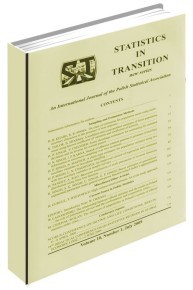A Modified Mixed Randomized Response Model
A Modified Mixed Randomized Response Model
Author(s): Housila P. Singh, Tanveer A. TarraySubject(s): Economy
Published by: Główny Urząd Statystyczny
Keywords: randomized response technique;simple random sampling;dichotomous population;estimation of proportion;privacy of respondents;sensitive characteristics
Summary/Abstract: Socio-economic investigations often relate to certain personal features that people wish to hide from others in comprehensive inquiries, detailed questionnaires include numerous items. Data on most of them are frequently easy to procure merely by asking, but a few others can be on sensitive issues for which people are not inclined to state honest responses. For example, most people prefer to conceal the truth regarding their savings, the extent of their accumulated wealth, their history of intentional tax evasion and other illegal and or unethical practices leading to earnings from clandestine sources, crimes, trade in contraband goods, susceptibility to intoxication, expenditures on addictions of various forms, homosexuality, and similar issues which are customarily disapproved of by society. Open or direct queries often fail to yield reliable data on such confidential aspects of human life. Warner (1965) developed an alternative survey technique that is known as randomized response (RR) technique. Greenberg et al. (1971) presented a revised version of Warner's (1965) technique for qualitative variables. Later various modifications were given by several researchers [see Chaudhuri (2011)]. Kim and Warde (2005) and Nazuk and Shabir (2010) presented mixed randomized response models using simple random sampling with replacement sampling scheme which improves the privacy of respondents. In this paper we have suggested a modified mixed randomized response model to estimate the proportion of a qualitative sensitive variable. Properties of the proposed randomized response model have been studied along with recommendations. It has been shown that the suggested randomized response model is always better than Kim and Warde’s (2005) model while it is better than Nazuk and Shabbir’s (2010) model under some realistic conditions. Numerical illustrations and graphs are also given in support of the present study.
Journal: Statistics in Transition. New Series
- Issue Year: 15/2014
- Issue No: 1
- Page Range: 67-82
- Page Count: 16
- Language: English

